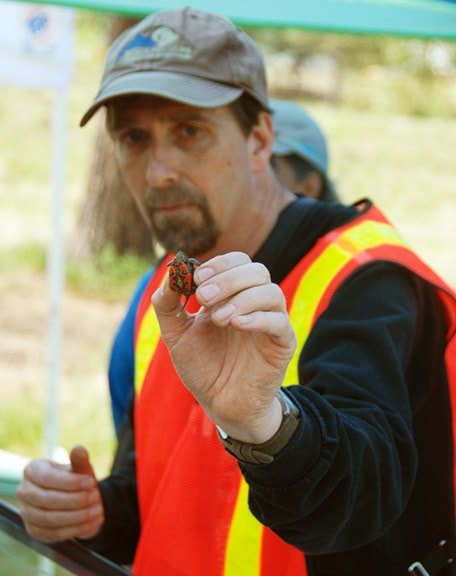The Western Painted Turtle was on full display on Tuesday afternoon at Elizabeth Lake as biologists and volunteers spent the afternoon educating the public about the creatures.
Set up by the rest area on the west end of the city, the displays included live turtles, shells and eggs. Wildsafe BC was also present with some animal skulls and pelts.
Roughly 130 school students came down to the lake in the morning to learn about the turtles before the displays opened up to the public in the afternoon.
Turtle Day is all about connecting people with the environment and the Western Painted Turtle because they're a pretty cool creature," said Angus Glass, the communications coordinator for the Fish and Wildlife Compensation Program. "They're right at the northern edge of their range in North America.
"Today is all about making sure people are aware of how cool the turtle is, how beautiful they are and how fragile they are because they are under considerable challenges from a variety of different quarters, whether it's predation or human impact…"
At this time of year, turtles are hatching from mid-April to mid-May. In June, the females will lay their eggs in the nests and head back to the water. For the next 11 months, the eggs will remain in the nests until hatching.
Adult turtles can live in the wild for more than 55 years and fossils have shown that painted turtles existed 15 million years ago.
Glass says that Elizabeth Lake is an important area for turtle habitat.
"Elizabeth Lake is a real key nesting place for Western Painted Turtles and there's a number of lakes around the East Kootenay area that are prime areas for Western Painted Turtles," Glass said.
About 14 years ago, the Rocky Mountain Naturalists became concerned about turtles coming up out of the lake and crossing the highway as they searched for nesting areas. Crossing the highway resulted in higher mortality rates, which was affecting the population, said Glass.
To solve the problem, a fence was installed down the bank from the highway, which prevented the turtles from crossing the road. A small sandy beachhead was prepared to allow turtles to create nesting areas closer to the lake.
"Before this fence was built alongside the road, they'd go hundreds of metres from the road," said Glass. "They're really good walkers, they can cover quite a distance. "We've actually forced them to nest closer to the lake by putting up that fence and keeping them off the highway because mortality has been quite significant.
The lake is good, it's a great size, there's lots of food, [and] the population, I believe, is quite stable."
While Elizabeth Lake seems to have a stable population of the Western Painted Turtle, the species is blue-listed, meaning it is vulnerable and endangered. Human development and the ever-shrinking wetland habitat has been large contributors to their blue-list status. Invasive weeds have also been a factor, as the weeds will grow around the nest and trap the hatchlings.
The biggest thing to stopping the decline of the turtles is awareness of their habitat and their fragility, said Glass.
"By ensuring that we don't move into their territory too much and respect their ability to move back into ours a little bit, I think that will help," he said.
